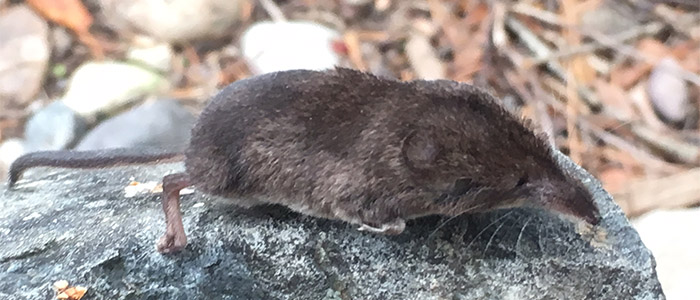Drama Underfoot

By Karen Menard
Drama happens often underfoot in the woods -- tireless, two- to four-inch furry beasts called “shrews” with voracious appetites and the ability to deliver venomous bites to very small animals, lurk and forage just below the leaf litter in their underground runways.
Being one makes for a lifetime of busy days, and nights, as they take short, intermittent rest breaks lasting just a few minutes, not really even sleeping.
There is no taming the shrew. Constantly seeking out worms, slugs, small mammals, insects and other invertebrates, shrews are forever on a mission to plunder their next victim. Due to an incredibly high metabolic rate with their heart racing up to about 1,300 beats per minute, they must locate and devour enough prey in a 24 hour period equivalent to their own weight of 5 to 25 grams, depending on the species. Five grams is about equal to one nickel, and one average-sized earthworm weighs about one gram. An individual weighing 25 grams would have to locate and consume 25 earthworms daily to meet its dietary requirement. Being deprived of a meal for just a few hours could quickly lead to starvation and death.
These animals also possess the fearless ability to successfully take on prey larger than themselves and are capable of killing the young of very small mammals, adult mice and frogs with a potent neurotoxin found in their saliva. They, however, are not dangerous to humans or domestic animals.
Producing a foul odor and nasty taste makes them unpalatable to many other mammals. Often, people may encounter a dead shrew which was, most likely, expelled to the ground by a larger mammal like a coyote or fox. Predators that aren’t easily deterred by this survival strategy include hawks and owls which lack a strong sense of smell and swallow their prey whole.
Similar to bats, shrews rely on echolocation or sonar to help determine their location and how best to navigate through dark conditions. They emit twittering sounds of varying pitch to examine their own surroundings by analyzing the returning noise.
Their overall eyesight is lacking in that their small, beady eyes just distinguish light from dark.
Shrews are overall amazing animals with incredible adaptations and strategies for survival. Considered beneficial, their ability to ingest large amounts of invertebrate pests helps to sustain healthy ecosystems in our woodlands and gardens.
Mostly residing out of our field of view, their covert antics play out daily often in unexpected ways for many different types of prey they may encounter while darting across the forest floor.
Did you know?
Shrews are not rodents and are more closely related to moles. They also happen to belong to the rarest class of life forms—the venomous mammal.
--
Photo: Masked shrew (Sorex cinereus) at the Fallen Timbers Battlefield, by Karen Menard